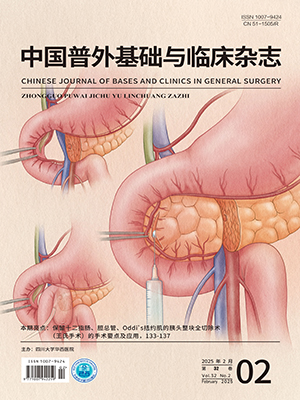| 1. |
Debs T, Petrucciani N, Kassir R, et al. Laparoscopic conversion of sleeve gastrectomy to one anastomosis gastric bypass for weight loss failure: mid-term results. Obes Surg, 2020, 30(6): 2259-2265.
|
| 2. |
Angrisani L, Santonicola A, Iovino P, et al. IFSO Worldwide Survey 2016: primary, endoluminal, and revisional procedures. Obes Surg, 2018, 28(12): 3783-3794.
|
| 3. |
郭沛, 刘朋朋, 侯栋升, 等. 腹腔镜袖状胃切除术治疗不同肥胖程度单纯性肥胖症的疗效分析. 中国普外基础与临床杂志, 2021, 28(2): 208-211.
|
| 4. |
Woźniewska P, Diemieszczyk I, Hady HR. Complications associated with laparoscopic sleeve gastrectomy—a review. Prz Gastroenterol, 2021, 16(1): 5-9.
|
| 5. |
马钰栋, 周爱明, 顾德智, 等. 腹腔镜袖状胃切除术后早期并发症的影响因素分析. 中国普外基础与临床杂志, 2023, 30(5): 582-586.
|
| 6. |
Oshiro T, Wakamatsu K, Nabekura T, et al. Treatments for staple line leakage after laparoscopic sleeve gastrectomy. J Clin Med, 2023, 12(10): 3495. doi: 10.3390/jcm12103495.
|
| 7. |
Al-Kurd A, Grinbaum R, Abubeih A, et al. Not all leaks are created equal: a comparison between leaks after sleeve gastrectomy and Roux-en-Y gastric bypass. Obes Surg, 2018, 28(12): 3775-3782.
|
| 8. |
Sobhani Z, Moein Vaziri N, Hosseini B, et al. Late gastropleural fistula after the management of laparoscopic sleeve gastrectomy leakage. Obes Surg, 2020, 30(9): 3620-3623.
|
| 9. |
Aljahdli ES, Aldabbagh A, Salah F, et al. Endoscopic management of post-laparoscopic sleeve gastrectomy leakage and stenosis using fully covered stent. Saudi J Med Med Sci, 2021, 9(1): 45-50.
|
| 10. |
Iossa A, Abdelgawad M, Watkins BM, et al. Leaks after laparoscopic sleeve gastrectomy: overview of pathogenesis and risk factors. Langenbecks Arch Surg, 2016, 401(6): 757-766.
|
| 11. |
Elariny H, González H, Wang B. Tissue thickness of human stomach measured on excised gastric specimens from obese patients. Surg Technol Int, 2005, 14: 119-124.
|
| 12. |
Huang R, Gagner M. A thickness calibration device is needed to determine staple height and avoid leaks in laparoscopic sleeve gastrectomy. Obes Surg, 2015, 25(12): 2360-2367.
|
| 13. |
Barski K, Binda A, Jaworski P, et al. Influence of preoperative weight loss on gastric wall thickness-analysis of laparoscopic sleeve gastrectomy histological material. Langenbecks Arch Surg, 2022, 407(8): 3315-3322.
|
| 14. |
Susmallian S, Goitein D, Barnea R, et al. Correct evaluation of gastric wall thickness may support a change in staplers’ size when performing sleeve gastrectomy. Isr Med Assoc J, 2017, 19(6): 351-354.
|
| 15. |
Rosenthal RJ, Diaz AA, et al. International Sleeve Gastrectomy Expert Panel Consensus Statement: best practice guidelines based on experience of >12 000 cases. Surg Obes Relat Dis, 2012, 8(1): 8-19.
|
| 16. |
Endo Y, Ohta M, Kawamura M, et al. Gastric wall thickness and linear staple height in sleeve gastrectomy in Japanese patients with obesity. Obes Surg, 2022, 32(2): 349-354.
|
| 17. |
Barski K, Binda A, Kudlicka E, et al. Gastric wall thickness and stapling in laparoscopic sleeve gastrectomy—a literature review. Wideochir Inne Tech Maloinwazyjne, 2018, 13(1): 122-127.
|
| 18. |
Gong S, Wang K, Li Y, et al. Ethnic group differences in obesity in Asian Americans in California, 2013–2014. BMC Public Health, 2021, 21(1): 1589. doi: 10.1186/s12889-021-11612-z.
|
| 19. |
Rawlins L, Rawlins MP, Teel D. Human tissue thickness measurements from excised sleeve gastrectomy specimens. Surg Endosc, 2014, 28(3): 811-814.
|
| 20. |
Boeker C, Mall J, Reetz C, et al. Laparoscopic sleeve gastrectomy: investigation of fundus wall thickness and staple height-an observational cohort study: fundus wall thickness and leaks. Obes Surg, 2017, 27(12): 3209-3214.
|
| 21. |
van de Vrande S, Himpens J, El Mourad H, et al. Management of chronic proximal fistulas after sleeve gastrectomy by laparoscopic Roux-limb placement. Surg Obes Relat Dis, 2013, 9(6): 856-861.
|
| 22. |
Lee YJ, Kim YN, Park S. Measurement of stomach wall thickness to guide staple selection during sleeve gastrectomy. Obes Surg, 2020, 30(6): 2140-2146.
|
| 23. |
Abu-Ghanem Y, Meydan C, Segev L, et al. Gastric wall thickness and the choice of linear staples in laparoscopic sleeve gastrectomy: challenging conventional concepts. Obes Surg, 2017, 27(3): 837-843.
|
| 24. |
Chekan E, Whelan RL. Surgical stapling device-tissue interactions: what surgeons need to know to improve patient outcomes. Med Devices (Auckl), 2014, 7: 305-318.
|




